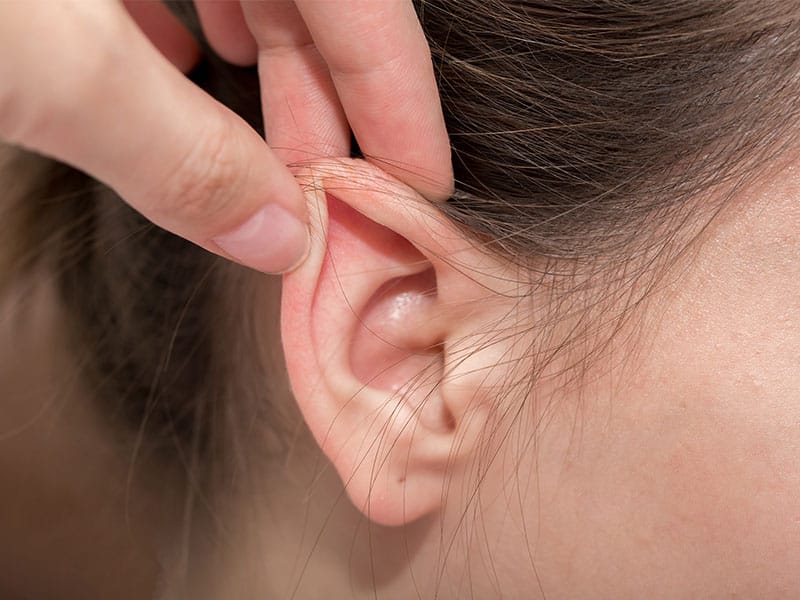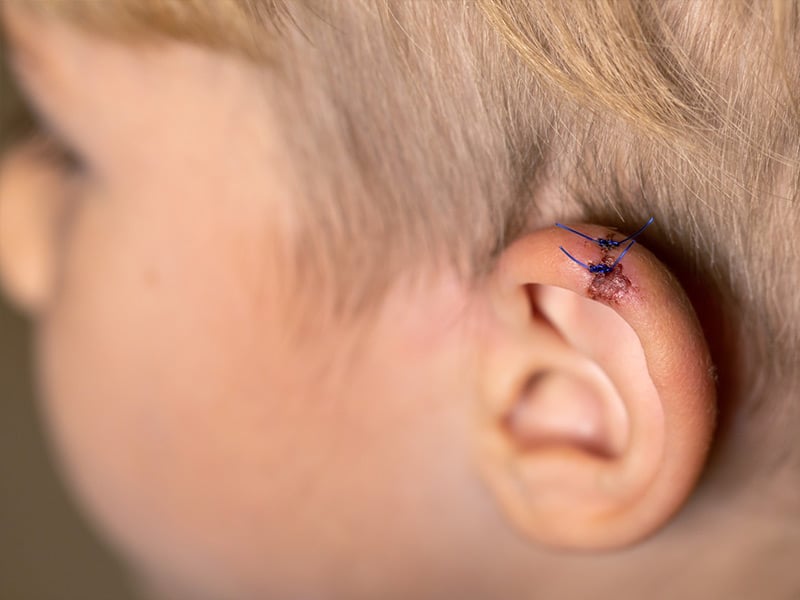Otoplasty
in New Jersey & Philadelphia
Home » Procedures » Otoplasty
Otoplasty, also known as “ear pinning” surgery, is the permanent surgical reshaping of the outer ear. At Yamaski Facial Plastic Surgery, Dr. Alisa Yamasaki offers otoplasty for people who are bothered by the size, shape, or position of their ears. Otoplasty is an effective cosmetic ear surgery that reshapes the ears to bring symmetry and balance to a person’s face.This procedure is not only beneficial for aesthetic reasons but can also help boost self-esteem for those who feel self-conscious about their ears.

Experience the Excellence of Dr. Yamasaki, Harvard-Trained Facial Plastic Surgeon.

What Is Otoplasty?
Some people may be bothered by the appearance of their ears because they feel they are protruding, overly large, asymmetrical, or misshapen. For example, some ears may be cupped or have abnormal folds that make the ear stand out. This can be from the anatomy that you are born with or can be a result of trauma, infection, or prior surgery. Otoplasty is a surgical procedure to correct the structure, shape, or position of the ears. Otoplasty is intended as a permanent treatment that can be performed on both adults and children, once the ears have fully developed. This occurs at around age 5 in most cases.
Otoplasty Benefits
Otoplasty can have a significant impact on patients by improving your appearance, making the ears appear less noticeable, and boosting your self-confidence. Correcting even the most minor ear deformities can make a major effect on how a person looks and feels. Dr. Yamasaki understands this and always applies her full range of plastic surgery expertise to help patients achieve their goals.
Otoplasty surgery can help patients bothered by prominent ears, protruding ears, or misshapen ears. This surgical procedure offers many benefits to patients including:
01
Improved Ear Aesthetics
02
Enhanced Self-Confidence
03
Permanent Results
04
Minimal Scarring
05
Suitable for All Ages
06
Customizable
07
Quick Recovery
08
Boosts Quality of Life
Otoplasty Consultation

It was a pleasure meeting Dr Yamasaki
“This office visit was worth 5 stars. The staff was very courteous and professional, in providing their services. It was a pleasure meeting Dr Yamasaki for the first time. She made me feel very comfortable, and was very thorough with her examination, and explanation of her findings.”
Wendy Benjamin
The Ideal Candidate for Otoplasty
The ideal candidate for otoplasty is someone who is self-conscious about the appearance of their ears and is seeking to correct protruding ears, overly large ears, asymmetrical ears, or other issues with the shape of the ears. Candidates may include adults or children over the age of five, when the ear cartilage is strong and developed enough for procedural correction. Children should also have a basic understanding of the purpose of surgery and be able to follow pre- and postoperative care instructions.
Ideal candidates are in good overall health, nonsmokers, and without a history of poor wound healing or scarring (e.g., keloids). Patients should have realistic expectations about the outcomes of the surgery and be ready to make a long-term change to the appearance of the ears.
The Otoplasty Procedure
Because ear anatomy is complex and each patient’s anatomy is unique, Dr. Yamasaki customizes every treatment plan to the individual patient. In general, the procedure typically involves making an incision behind the ear and/or along the creases of the ear folds to access the cartilage. The ear is then sculpted, folded, and/or resized to create the desired shape and position. The incisions are carefully closed to minimize visible scarring. A compression bandage is usually placed on the ears when the procedure is finished to protect the surgical sites as they heal.
Otoplasty is most commonly performed on both ears to help improve the appearance of the individual ears as well as the symmetry between the two ears, though on rare occasions surgery is only needed on one ear.
Otoplasty can be performed on both children and adults and is typically performed under local anesthesia in the office for adult patients. For children, the procedure is typically performed under general anesthesia in the operating room. Recovery involves a brief period of downtime, during which patients may need to wear bandages or a headband to support the new ear shape. The results are generally permanent, providing improved ear aesthetics and enhanced self-confidence.
Before & After Otoplasty

Otoplasty Recovery
Dr. Yamasaki will place a compression dressing around the ears after the surgery is complete. She will provide you with instructions regarding the dressing after surgery, though wound care is generally minimal. After the initial compression dressing is removed, it is usually advised to wear a headband to protect the ears for a few weeks. You may need to avoid wearing glasses during recovery time, as this may irritate the incision sites. Typically, pain is mild and controlled with over-the-counter pain medications.
Typically, patients can resume normal physical activity within one week or so. It may take a few weeks to months for all of the swelling to fully subside, but you will see a dramatic change immediately after the surgery is complete.
Risks and side effects of this plastic surgery include bleeding, infection, pain, and swelling/bruising. Rarely will patients have issues with the scar, as this area tends to heal very well. Be sure to keep all post-surgery follow-up appointments with Dr. Yamasaki, as she will monitor your recovery and ensure you are healing as best as possible.
Otoplasty Cost
After you are evaluated at your consultation, Dr. Yamasaki will formulate your treatment plan. A cost estimate will then be provided by Dr. Yamasaki’s office. Be sure to discuss financing options such as Care Credit if you are interested in learning more.
Why Choose Dr. Yamasaki for Your Otoplasty
- Renowned Expertise: Board-certified and fellowship-trained, Dr. Yamasaki is a top specialist in otolaryngology and facial plastic surgery.
- Prestigious Affiliations: Dr. Yamasaki’s association with Penn Medicine and her experience at top institutions like Harvard and the University of Michigan ensure multidisciplinary, superior care.
- Personalized Patient Care: Dr. Yamasaki provides customized treatments using advanced surgical and non-surgical procedures to meet patients’ specific goals.
- Extensive Experience: Dr. Yamasaki’s experience in numerous procedures, from rhinoplasty to skin cancer reconstruction, ensures high-quality treatment outcomes.
- Academic Contributions: With nearly 50 publications, Dr. Yamasaki remains at the forefront of otolaryngology research, enhancing her practice with the latest advancements.

Dr. Alisa Yamasaki, MD, is a Harvard-trained Facial Plastic Surgeon and board-certified Otolaryngologist–Head and Neck Surgeon specializing in ear reshaping and facial reconstructive surgery. She offers otoplasty (ear surgery) to correct prominent or misshapen ears, helping patients achieve a more balanced and natural appearance.
Otoplasty can address concerns such as protruding ears, asymmetry, and ear deformities, providing lasting results with minimal downtime. Dr. Yamasaki serves patients in New Jersey and Philadelphia. If you’re considering ear reshaping surgery, schedule a consultation with Dr. Yamasaki today.
Common Otoplasty Questions
Who is an ideal candidate for otoplasty?
An ideal candidate for otoplasty is someone who desires a permanent solution to enhance their ear aesthetics and boost self-confidence. This includes individuals with protruding, large, asymmetrical, or deformed ears due to congenital conditions or trauma. Suitable candidates are typically healthy, non-smokers, and have no wound healing issues or poor scarring. Patients should have realistic expectations about the outcomes of surgery and be able to follow post-operative care instructions. Children over the age of five may also be surgical candidates as long as they are able to follow instructions and cooperate with treatment.
What are the side effects associated with otoplasty?
Though otoplasty is generally safe. Incisions are hidden in inconspicuous locations behind the ears or within the ear folds, and these incisions tend to camouflage well. However, as with any surgery, there are some risks involved. These include infection, bleeding, mild pain, swelling, bruising, and fluid accumulation in the surgical sites. The initial swelling and bruising should subside in one or two weeks and residual swelling should resolve over the course of a few weeks to months.
When will I see my otoplasty results?
You will see your initial otoplasty results as soon as the surgery is complete. However, as the surgical swelling subsides within the first two weeks, you will notice an even clearer view of the new ear shape. It can take several weeks to months for all residual swelling to completely resolve and for the ears to settle into their final position.
How long will otoplasty results last?
Otoplasty results are generally permanent, as the surgical adjustments to the ear’s cartilage and structure are designed to last a lifetime. Once the ears have healed and settled into their new shape, which typically takes a few months, the results should remain stable. Barring any significant trauma or changes to the ear, patients can expect their improved ear appearance to be long-lasting.
Is otoplasty right for me?
If you are self-conscious about protruding, large, asymmetrical, or deformed ears, otoplasty could be the right option for you. Correcting the shape of your ears, however minor, can improve your facial proportions and help you to regain your confidence. Schedule a consultation with Dr. Yamasaki to see if you are a good candidate for otoplasty surgery.
